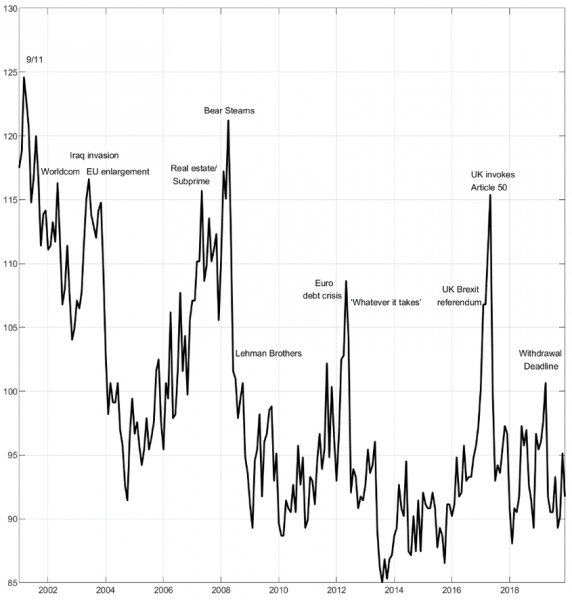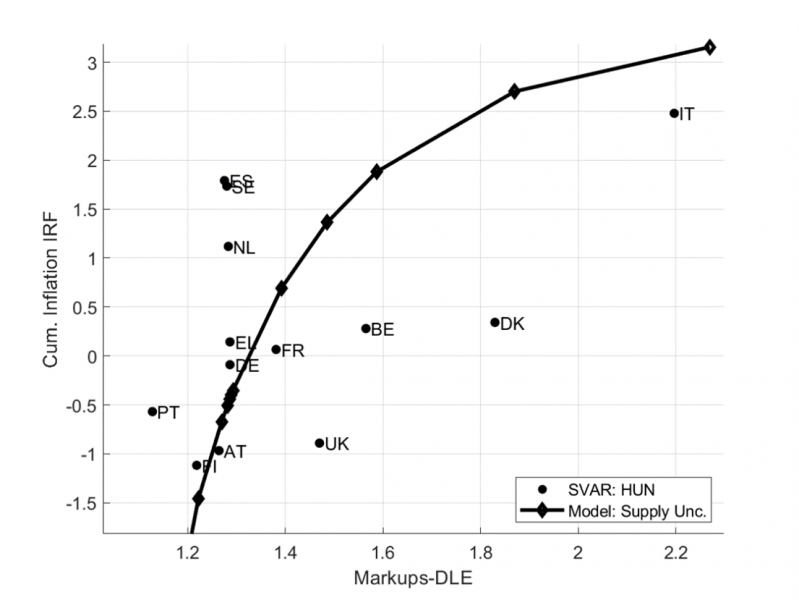

I show, using a measure of uncertainty based on household surveys, that household uncertainty raises both unemployment and inflation for many countries in Europe. This result is driven by the precautionary pricing behavior of firms which, in contrast to precautionary savings by households, leads to higher prices following increases in uncertainty. Higher average markups, a symptom of more market power by firms, is associated with more inflation following increases in uncertainty.
Macroeconomic uncertainty tends to rise during crises and is widely thought to also exacerbate the downturn that typically follows. Numerous studies have empirically shown that increases in macroeconomic uncertainty, measured in various ways, tend to lower output, investment, and employment. A key theoretical mechanism behind this finding is the precautionary savings behavior by households – the desire to postpone current consumption in order to save more for the future. Hence, increases in uncertainty are usually treated as something akin to a fall in aggregate demand which results in lower output and prices. However, most measures of macro uncertainty currently in use – typically derived from financial markets data, surveys of professional forecasters, or even econometrically – are not directly indicative of what households are actually thinking. In order to capture precautionary savings behavior well, one would want to measure household uncertainty as directly as possible. In a recent paper (Ambrocio, 2022), I propose such a measure for European countries.
The measure for household uncertainty is based on the fraction of households who say they “Don’t know” when asked about what they expect general economic conditions, unemployment, and their own financial situation to be over the coming year. Figure 1 plots how the household uncertainty measure for the Euro area as a whole has evolved over the last two decades. The measure is elevated precisely at the points in time where one would think that European households would be most uncertain about the future such as during the Global Financial Crisis, the European Sovereign Debt Crisis, and key events related to Brexit.
Figure 1. Household uncertainty in the Euro area2

However, unlike what one would expect with a fall in aggregate demand, I find that increases in household uncertainty tends to raise both unemployment and inflation for many European countries and for the Euro area as a whole.3 This is in contrast to the estimated effects of financial uncertainty for which I find an increase in unemployment but a decrease in inflation. Further, additional analysis reveals that part of the reason why inflation falls following an increase in financial uncertainty may be because of a monetary policy response – a response not detected when it comes to increases in household uncertainty. More importantly, the finding that household uncertainty is inflationary indicates that other mechanisms aside from deflationary household precautionary savings behavior play a material role in the transmission of household uncertainty to prices.
One such mechanism is the precautionary pricing behavior of firms which arise in monopolistic-competitive settings such as those assumed in New Keynesian models.4 As described in earlier work by Born and Pfeifer (2014) and Fernandez-Villaverde et al. (2015), firms find it optimal to raise prices when faced with higher uncertainty – a precautionary increase in prices. Through this precautionary pricing behavior by firms, higher uncertainty can lead to more inflation. This mechanism also tends to be stronger when firms have more market power. Consistent with this prediction, I find that increases in household uncertainty results in more inflation for countries where average markups – indicating more market power by firms – are also higher. Figure 2 illustrates these results. Both in a prototypical New Keynesian model (solid line) and the data (dots with country code labels), I find that higher average markups are associated with more inflation following an increase in uncertainty.
Figure 2. Average markups and inflationary uncertainty5

These results indicate that the macroeconomic effects of increases in uncertainty operate through multiple channels which can have opposing effects on inflation. In turn, this implies that differences in economic structures which determine the relative strengths of the various mechanisms can lead to significantly differing effects of uncertainty on inflation. For instance, as indicated in Figure 2, countries where firms have low market power such as Austria and Finland have deflationary household uncertainty shocks while countries where firms have high market power such as Italy have inflationary household uncertainty shocks.
Finally, the finding that the precautionary pricing behavior by firms is an important mechanism for the transmission of household uncertainty to prices raises several questions. Looking deeper into the interaction between how firms and households perceive uncertainty and also how they react to it is a key area for future research. It is hoped that the introduction of a new measure for household uncertainty available for multiple countries and over several decades would help facilitate progress on this front.6
Ambrocio, G., 2022. Inflationary household uncertainty shocks. Bank of Finland Discussion Paper 5/2022.
Basu, S., & Bundick, B., 2017. Uncertainty shocks in a model of effective demand. Econometrica, 85(3), 937-958.
Born, B. & Pfeifer, J., 2014. Policy risk and the business cycle. Journal of Monetary Economics, 68, 68-85.
De Loecker, J. & Eeckhout, J., 2020. Global market power. Working Paper.
Fernandez-Villaverde, J., Guerron-Quintana, P., Kuester, K., Rubio-Ramirez, J., 2015. Fiscal volatility shocks and economic activity. American Economic Review, 105(11), 3352-3384.
Contact: gene.ambrocio(at)bof.fi. The views expressed in this brief are those of the author and do not necessarily reflect the views of the Bank of Finland.
The index has been standardized such that 100 is the historical mean and 10 points represents one standard deviation.
These findings are based on impulse responses from recursively identified vector-autoregressions. In Ambrocio (2022), I show that these findings are robust to numerous concerns including those regarding shock identification.
Nominal rigidities, the hallmark of the New Keynesian framework, has been highlighted as a key ingredient to the dampening effects of uncertainty as demonstrated in e.g., Basu and Bundick (2017).
The diamonds connected with a solid black line represent the cumulated model-implied responses of inflation to an uncertainty shock over a four-year period on the vertical axis and across different calibrations of average firm markups on the horizontal axis. The dots labeled with country codes report the responses to increases in household uncertainty (HUN) estimated from the data using vector auto-regressions. Average markups are obtained from De Loecker and Eeckhout (2020). Country codes are official European Union two letter designations.
Recent changes to the harmonized European business and consumer surveys can provide new data that may also be helpful in pursuing this agenda. See Section 2 of the European Commission’s European Business Cycle Indicators 3rd Quarter 2021 report available online at: https://ec.europa.eu/info/publications/economic-and-financial-affairs-publications_en.